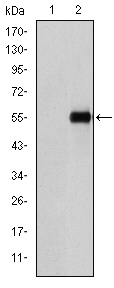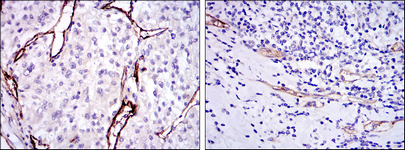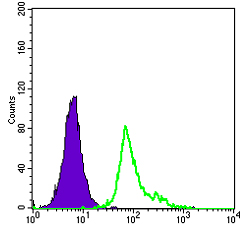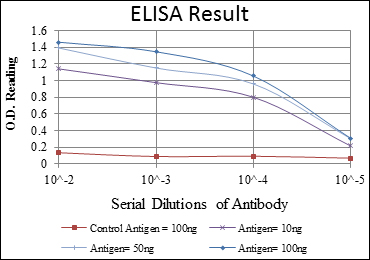CD105 Monoclonal Antibody
- Catalog No.:YM0101
- Applications:WB;IHC;IF;FCM;ELISA
- Reactivity:Human
- Target:
- CD105(Endoglin)
- Gene Name:
- ENG
- Protein Name:
- Endoglin
- Human Gene Id:
- 2022
- Human Swiss Prot No:
- P17813
- Mouse Swiss Prot No:
- Q63961
- Immunogen:
- Purified recombinant fragment of human CD105 expressed in E. Coli.
- Specificity:
- CD105 Monoclonal Antibody detects endogenous levels of CD105 protein.
- Formulation:
- Liquid in PBS containing 50% glycerol, 0.5% BSA and 0.02% sodium azide.
- Source:
- Monoclonal, Mouse
- Dilution:
- WB 1:500 - 1:2000. IHC 1:200 - 1:1000. IF 1:200 - 1:1000. Flow cytometry: 1:200 - 1:400. ELISA: 1:10000. Not yet tested in other applications.
- Purification:
- Affinity purification
- Storage Stability:
- -15°C to -25°C/1 year(Do not lower than -25°C)
- Other Name:
- ENG;END;Endoglin;CD antigen CD105
- Molecular Weight(Da):
- 71kD
- References:
- 1. Int J Cancer. 2009 Feb 1;124(3):664-9.
2. Reprod Sci. 2008 Dec;15(10):1018-26.
- Background:
- This gene encodes a homodimeric transmembrane protein which is a major glycoprotein of the vascular endothelium. This protein is a component of the transforming growth factor beta receptor complex and it binds to the beta1 and beta3 peptides with high affinity. Mutations in this gene cause hereditary hemorrhagic telangiectasia, also known as Osler-Rendu-Weber syndrome 1, an autosomal dominant multisystemic vascular dysplasia. This gene may also be involved in preeclampsia and several types of cancer. Alternatively spliced transcript variants encoding different isoforms have been found for this gene. [provided by RefSeq, May 2013],
- Function:
- disease:Defects in ENG are the cause of hereditary hemorrhagic telangiectasia type 1 (HHT1) [MIM:187300, 108010]; also known as Osler-Rendu-Weber syndrome 1 (ORW1). HHT1 is an autosomal dominant multisystemic vascular dysplasia, characterized by recurrent epistaxis, muco-cutaneous telangiectases, gastro-intestinal hemorrhage, and pulmonary (PAVM), cerebral (CAVM) and hepatic arteriovenous malformations; all secondary manifestations of the underlying vascular dysplasia. Although the first symptom of HHT1 in children is generally nose bleed, there is an important clinical heterogeneity.,function:Major glycoprotein of vascular endothelium. May play a critical role in the binding of endothelial cells to integrins and/or other RGD receptors.,subunit:Homodimer that forms an heteromeric complex with the signaling receptors for transforming growth factor-beta: TGF-beta receptors I and/or II. It
- Subcellular Location:
- Cell membrane ; Single-pass type I membrane protein .
- Expression:
- Detected on umbilical veil endothelial cells (PubMed:10625079). Detected in placenta (at protein level) (PubMed:1692830). Detected on endothelial cells (PubMed:1692830).
- June 19-2018
- WESTERN IMMUNOBLOTTING PROTOCOL
- June 19-2018
- IMMUNOHISTOCHEMISTRY-PARAFFIN PROTOCOL
- June 19-2018
- IMMUNOFLUORESCENCE PROTOCOL
- September 08-2020
- FLOW-CYTOMEYRT-PROTOCOL
- May 20-2022
- Cell-Based ELISA│解您多样本WB检测之困扰
- July 13-2018
- CELL-BASED-ELISA-PROTOCOL-FOR-ACETYL-PROTEIN
- July 13-2018
- CELL-BASED-ELISA-PROTOCOL-FOR-PHOSPHO-PROTEIN
- July 13-2018
- Antibody-FAQs
- Products Images

- Western Blot analysis using CD105 Monoclonal Antibody against HEK293 (1) and CD105-hIgGFc transfected HEK293 (2) cell lysate.

- Immunohistochemistry analysis of paraffin-embedded kidney cancer tissues (left) and stomach cancer tissues (right) with DAB staining using CD105 Monoclonal Antibody.

- Immunofluorescence analysis of HepG2 cells using CD105 Monoclonal Antibody (green). Blue: DRAQ5 fluorescent DNA dye. Red: Actin filaments have been labeled with Alexa Fluor-555 phalloidin.

- Flow cytometric analysis of HepG2 cells using CD105 Monoclonal Antibody (green) and negative control (purple).




